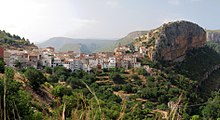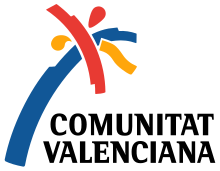Valencian Community
|
Comunidad Valenciana ( Spanish ) Comunitat Valenciana [official name] ( Valencian ) Valencian Community |
|||||
|---|---|---|---|---|---|
|
|||||
| Basic data | |||||
| Country : |
|
||||
| Capital : | Valencia | ||||
| Area : | 23,255 km² | ||||
| Residents : | 5,003,769 (January 1, 2019) | ||||
| Population density : | 215.2 inhabitants / km² | ||||
| Expansion: | North – South: approx. 330 km West – East: approx. 101 km |
||||
| ISO 3166-2 : | ES-VC | ||||
| Website : | www.gva.es | ||||
| Politics and administration | |||||
| Official language : | Spanish , Valencian | ||||
| Autonomy since: | July 10, 1982 | ||||
| President : | Ximo Puig ( PSPV-PSOE ) | ||||
| Representation in the Cortes Generales : |
Congress : 33 seats Senate : 5 seats |
||||
| Structure : | 3 provinces 34 comarcas |
||||
| map | |||||
The Valencian Community , also Valencian Land (officially val. Comunitat Valenciana , Spanish Comunidad Valenciana ), is an autonomous community of Spain located on the Mediterranean coast . It borders on Catalonia in the north, Aragon and Castile-La Mancha in the west and Murcia in the south and includes the three provinces of València , Alacant and Castelló . The capital of the Autonomous Community is the city of València .
The territory of the autonomous community formed in 1982 is largely identical to that of the former Kingdom of Valencia , which belonged to the Aragonese Crown .
languages
Most of the region belongs to the Valencian language area , a variety of Catalan . Valencian is the official language alongside Spanish . The population of the coastal landscape speaks Valencian and Spanish, especially in the rural areas mainly Valencian, while in the inland mountains and in the extreme south of the autonomous region only Spanish is spoken mostly.
Political structure
The Autonomous Community of Valencia comprises the three provinces of Alicante , Castellón and Valencia , which in turn can be divided into a total of 32 comarcas (districts) and the municipalities (cities).
The main institutions that govern and administer the Autonomous Region of Valencia , which together form the Generalitat Valenciana , the Administration, are as follows:
- The autonomous parliament “ Corts Valencianes ” with the legislative functions
- The government ("Consell") with the executive functions, with the Prime Minister ("President de la Generalitat Valenciana") at the head
Celebrations and holidays
Some cities celebrate the Moros i Cristians (Moors and Christians) fiestas , which commemorate the battles between the Muslim and Christian armies in the region in the Middle Ages, the Moors and Christians of Alcoy being the most famous. On St. Joseph's Day , March 19, the Falles are celebrated in many places , especially in the province of Valencia. Alicante is famous for the Fogueres de Sant Joan , celebrated in June . In March, the Magdalena is celebrated in Castellón ; in Elx the " Misteri d'Elx ". In the small town of Buñol (approx. 40 km from Valencia coming from Madrid), the world's largest tomato battle, Tomatina, takes place every year at the beginning of August .
The Day of the Autonomous Community of Valencia is celebrated on October 9th.
In addition to these holidays, there are nine Spanish-wide holidays and two local community holidays.
economy
In comparison with the GDP of the EU, expressed in purchasing power standards, the Region of Valencia achieved an index of 80 (EU-27: 100) ( 2015 ). The country is heavily indebted and was the first Spanish region to apply for help from the Fondo de Liquidez Autonómica rescue fund . In 2017 the unemployment rate was 18.2%.
With a score of 0.875, Valencia ranks 11th among the 17 Spanish Autonomous Communities in the Human Development Index .
See also
- Valencians
- Valencia Region Flag
- Coat of arms of the Valencian Community
- LRAU
- Comunidad Valenciana (cycling team)
- Moors and Christians from Alcoy
Web links
- Valencia Region Tourism Portal
- Valencia Region website (Valencian, Spanish and English)
- ( Page no longer available , search in web archives: Region of Valencia ) In: Spaniens Allgemeine Zeitung.
- The 7 wonders of the Comunidad Valencia
Individual evidence
- ↑ Cifras oficiales de población resultantes de la revisión del Padrón municipal a 1 de enero . Population statistics from the Instituto Nacional de Estadística (population update).
- ↑ Eurostat. Retrieved April 15, 2018 .
- ↑ Unemployment rate, by NUTS 2 regions. Retrieved November 5, 2018 .
- ^ Sub-national HDI - Area Database - Global Data Lab. Retrieved August 12, 2018 .
Coordinates: 39 ° 25 ′ N , 0 ° 32 ′ W








